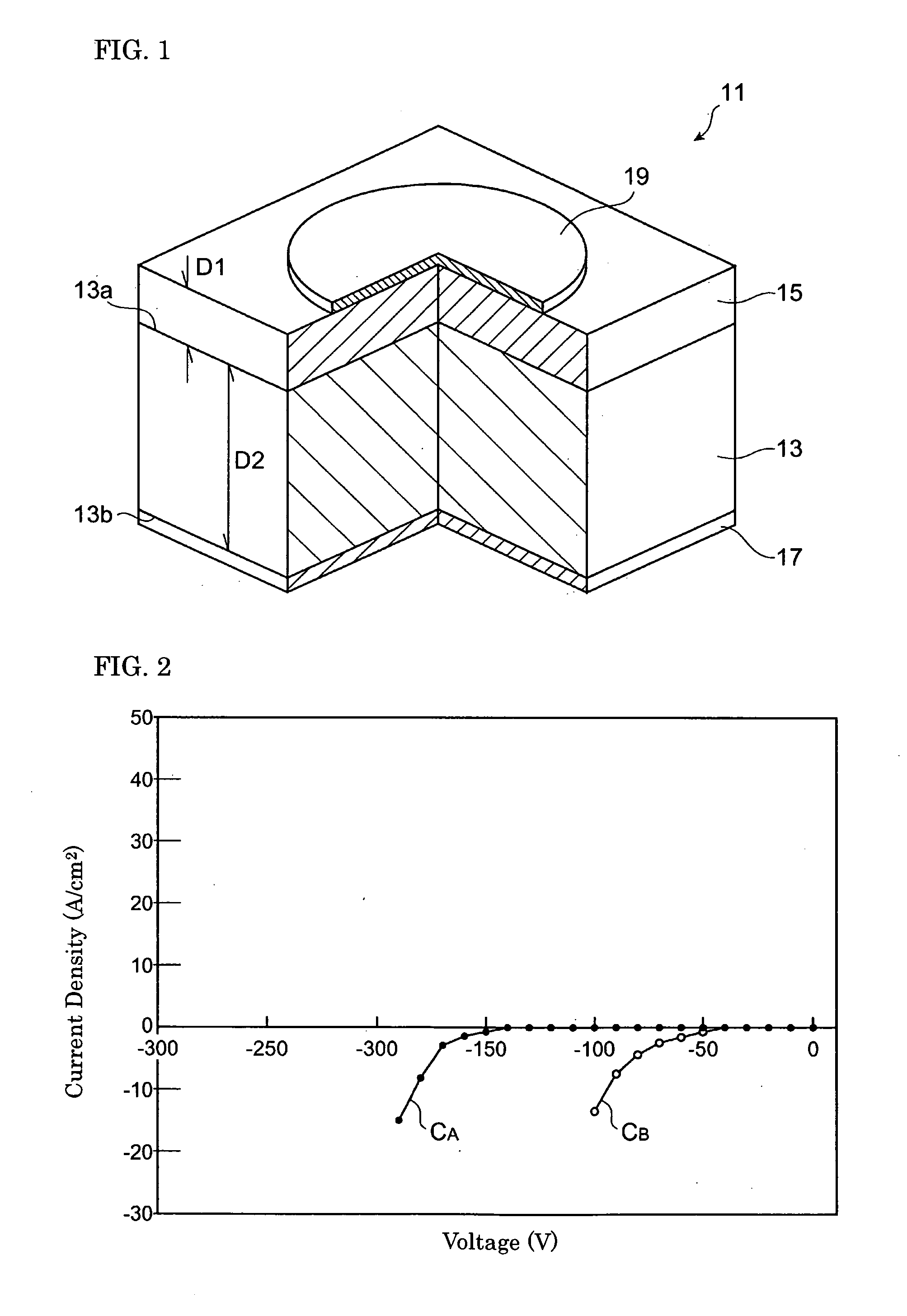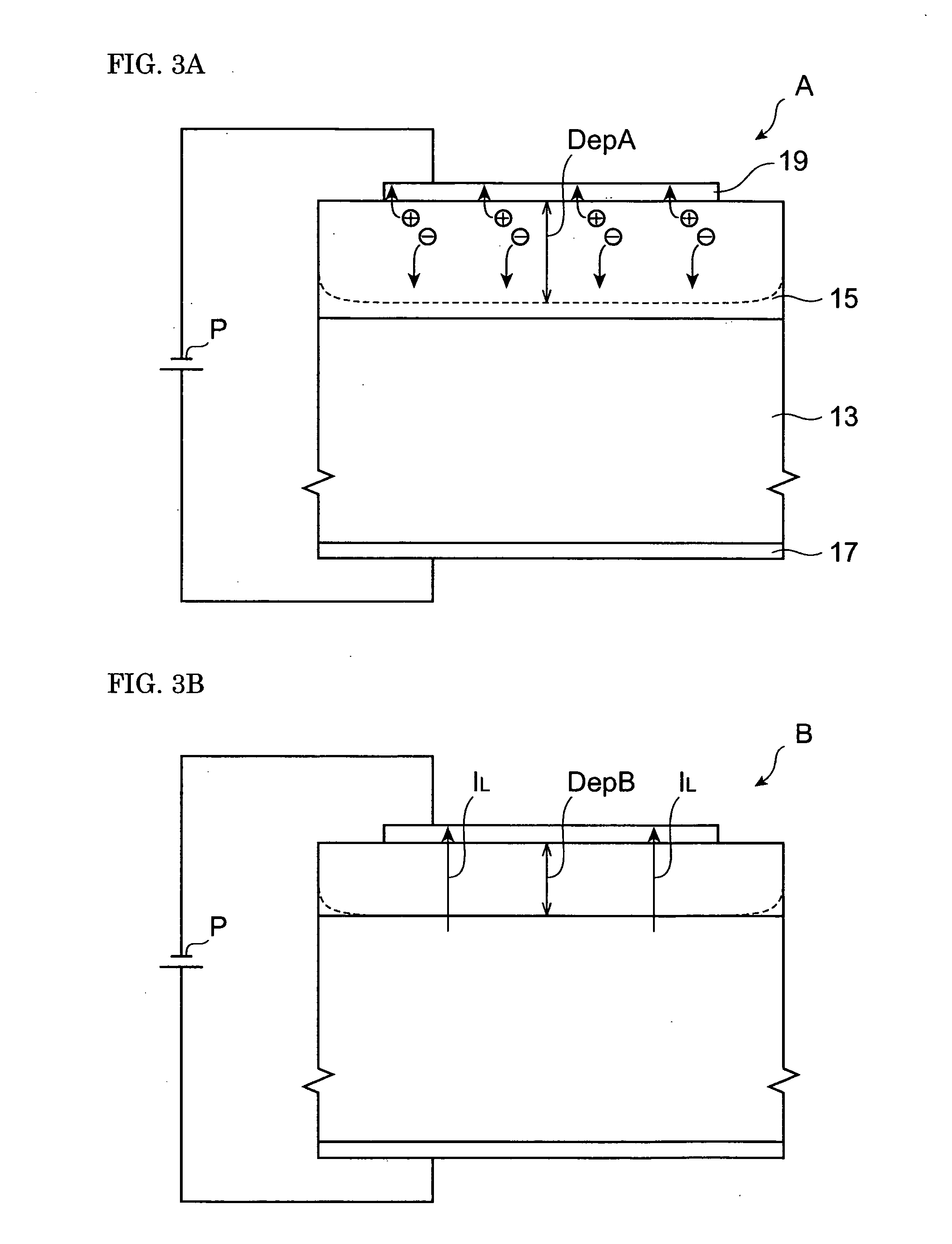Epitaxial substrate and semiconductor element
a technology of semiconductor elements and substrates, applied in the direction of basic electric elements, semiconductor devices, electrical apparatus, etc., can solve the problems of insufficient reverse blocking voltage of pin diodes in irokawa paper, inability to produce devices on low dislocation areas, complex device structure in this paper, etc., to achieve the effect of improving reverse breakdown
- Summary
- Abstract
- Description
- Claims
- Application Information
AI Technical Summary
Benefits of technology
Problems solved by technology
Method used
Image
Examples
first embodiment
(First Embodiment)
[0052]FIG. 1 shows a group III nitride semiconductor element according to a first embodiment of the present invention. This semiconductor element is a Schottky diode 11. The Schottky diode 11 is equipped with a gallium nitride support base 13, a gallium nitride epitaxial layer 15, an Ohmic electrode 17, and a Schottky electrode 19. The gallium nitride support base 13, which includes a first surface 13a and a second surface 13b opposite from the first surface, has a carrier concentration of over 1×1018 cm−3. The gallium nitride epitaxial layer 15 is disposed on the first surface 13a. The Ohmic electrode 17 is disposed on the second surface 13b. The Schottky electrode 19 is disposed on the gallium nitride epitaxial layer 15. The thickness D1 of the gallium nitride epitaxial layer 15 is 5 microns or more and 1000 microns or less. Also, the carrier concentration of the gallium nitride epitaxial layer 15 is 1×1014 cm−3 or more and 1×1017 cm−3 or less. With the carrier c...
first working example
[0055] An HPVE-produced (0001) face GaN free-standing substrate is prepared. A Schottky diode is produced using the procedure described below. The carrier concentration of an n-type conductor GaN free-standing substrate is 3×1018 cm−3, and the thickness is 400 microns. The average dislocation density in this substrate is 5×106 cm−2. An n-type conductor epitaxial film having a carrier concentration of 5×1015 cm−3 and a thickness of 20 microns is grown using HVPE on the GaN free-standing substrate, thus forming an epitaxial substrate (hereinafter referred to as sample A). An Ohmic electrode is formed on the back side of the substrate, and a Schottky electrode is formed on the epitaxial film. The Ohmic electrode is formed on the entire back surface of the substrate after organic cleaning is performed. To form the Ohmic electrode, Ti / Al / Ti / Au (20 nm / 100 nm / 20 nm / 300 nm) are formed using EB vapor deposition. After the Ohmic electrode film is formed, it is alloyed for approximately 1 minu...
second working example
[0058] An HPVE-produced (0001) face GaN free-standing substrate is prepared. The carrier concentration of the n-type conductor GaN free-standing substrate is 3×1018 cm−3, and the thickness is 400 microns. The average dislocation density in this substrate is 5×105 cm−2. An n-type conductor epitaxial film having a carrier concentration of 5×1015 cm−3 and a thickness of 20 microns is grown using HVPE on the GaN free-standing substrate, thus forming an epitaxial substrate (sample C). The process used in the first working example is used on this epitaxial substrate to produce a Schottky diode.
[0059]FIG. 4 is a drawing showing the I-V characteristics of sample A and sample C. In FIG. 4, the characteristic curve CA indicates the characteristics of sample A, and a characteristic curve Cc indicates the characteristics of sample C. The average dislocation density in the GaN free-standing substrate of sample A is 5×106 cm−2, while the average dislocation density in the GaN free-standing subst...
PUM
| Property | Measurement | Unit |
|---|---|---|
| carrier concentration | aaaaa | aaaaa |
| thickness | aaaaa | aaaaa |
| thickness | aaaaa | aaaaa |
Abstract
Description
Claims
Application Information
 Login to View More
Login to View More - R&D
- Intellectual Property
- Life Sciences
- Materials
- Tech Scout
- Unparalleled Data Quality
- Higher Quality Content
- 60% Fewer Hallucinations
Browse by: Latest US Patents, China's latest patents, Technical Efficacy Thesaurus, Application Domain, Technology Topic, Popular Technical Reports.
© 2025 PatSnap. All rights reserved.Legal|Privacy policy|Modern Slavery Act Transparency Statement|Sitemap|About US| Contact US: help@patsnap.com



